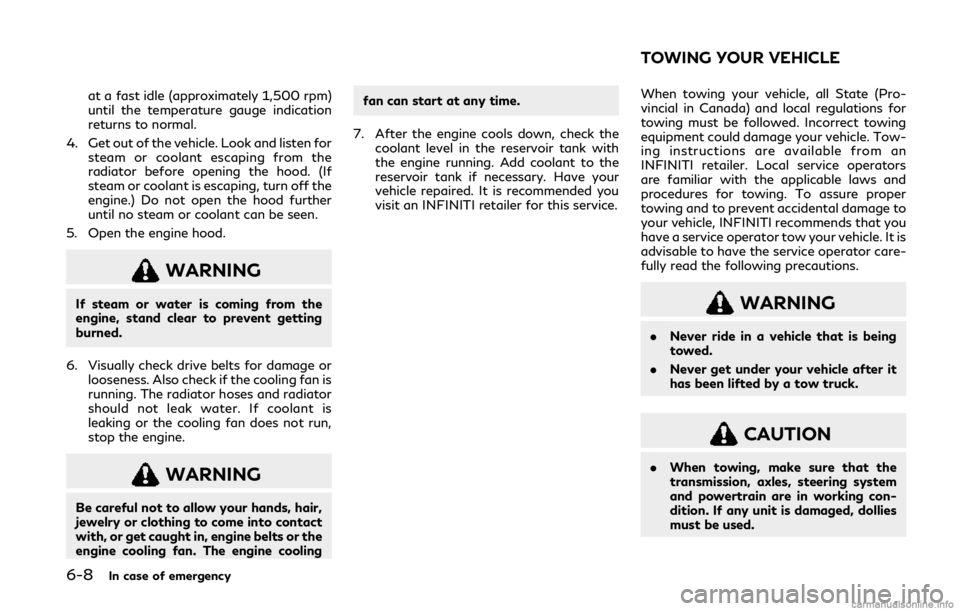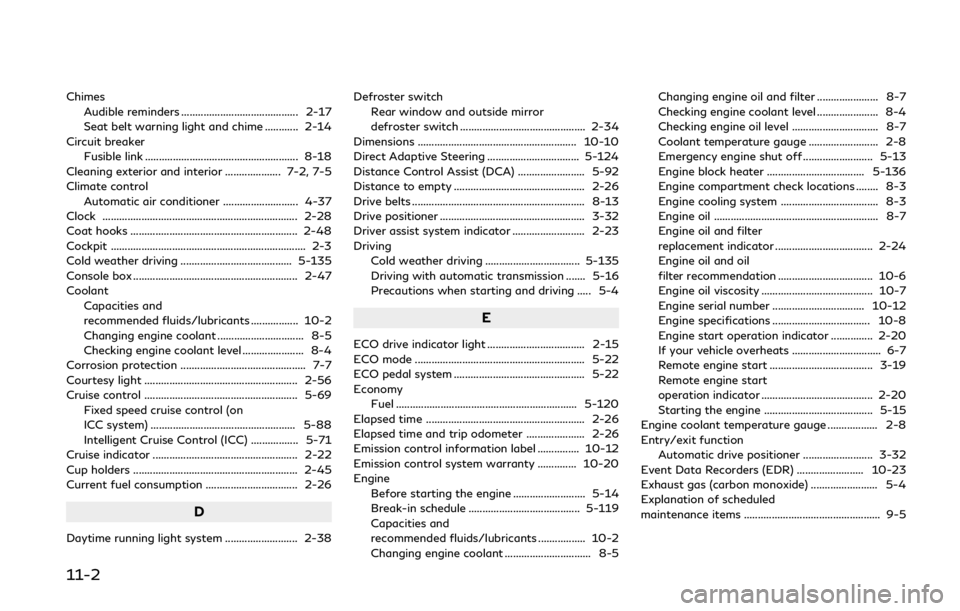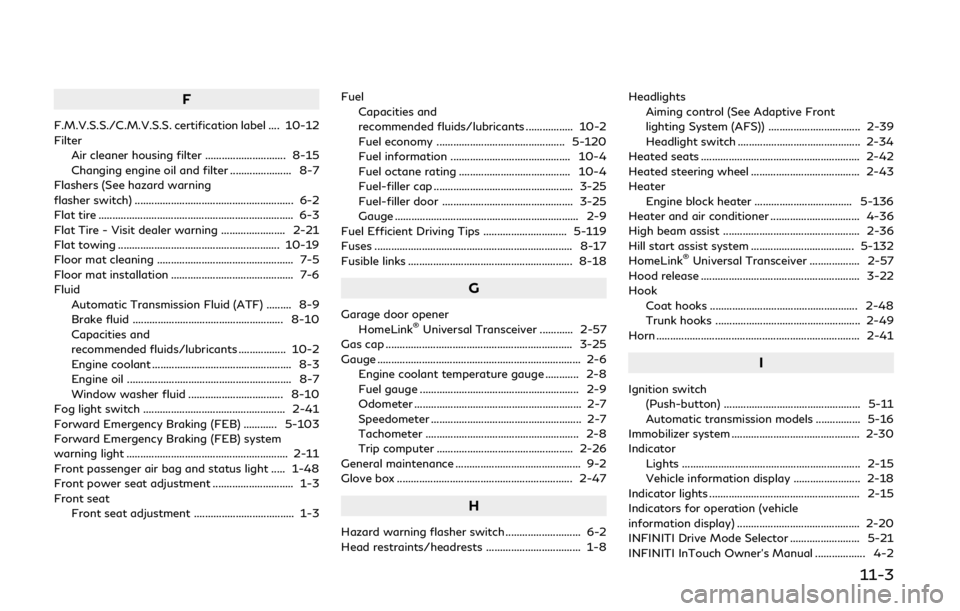steering INFINITI Q50 2020 Manual PDF
[x] Cancel search | Manufacturer: INFINITI, Model Year: 2020, Model line: Q50, Model: INFINITI Q50 2020Pages: 468, PDF Size: 2.18 MB
Page 364 of 468

6-8In case of emergency
at a fast idle (approximately 1,500 rpm)
until the temperature gauge indication
returns to normal.
4. Get out of the vehicle. Look and listen for steam or coolant escaping from the
radiator before opening the hood. (If
steam or coolant is escaping, turn off the
engine.) Do not open the hood further
until no steam or coolant can be seen.
5. Open the engine hood.
WARNING
If steam or water is coming from the
engine, stand clear to prevent getting
burned.
6. Visually check drive belts for damage or looseness. Also check if the cooling fan is
running. The radiator hoses and radiator
should not leak water. If coolant is
leaking or the cooling fan does not run,
stop the engine.
WARNING
Be careful not to allow your hands, hair,
jewelry or clothing to come into contact
with, or get caught in, engine belts or the
engine cooling fan. The engine cooling fan can start at any time.
7. After the engine cools down, check the coolant level in the reservoir tank with
the engine running. Add coolant to the
reservoir tank if necessary. Have your
vehicle repaired. It is recommended you
visit an INFINITI retailer for this service. When towing your vehicle, all State (Pro-
vincial in Canada) and local regulations for
towing must be followed. Incorrect towing
equipment could damage your vehicle. Tow-
ing instructions are available from an
INFINITI retailer. Local service operators
are familiar with the applicable laws and
procedures for towing. To assure proper
towing and to prevent accidental damage to
your vehicle, INFINITI recommends that you
have a service operator tow your vehicle. It is
advisable to have the service operator care-
fully read the following precautions.
WARNING
.
Never ride in a vehicle that is being
towed.
. Never get under your vehicle after it
has been lifted by a tow truck.
CAUTION
.When towing, make sure that the
transmission, axles, steering system
and powertrain are in working con-
dition. If any unit is damaged, dollies
must be used.
TOWING YOUR VEHICLE
Page 365 of 468

.Always attach safety chains before
towing.
For information about towing your vehicle
behind a recreational vehicle (RV), see “Flat
towing” (P.10-19) of this manual.
SCE0788
Two-Wheel Drive (2WD) models
TOWING RECOMMENDED BY
INFINITI
Two-Wheel Drive (2WD) models
INFINITI recommends that your vehicle be
towed with the driving (rear) wheels off the
ground or place the vehicle on a flat bed
truck as illustrated.
CAUTION
. Never tow automatic transmission
models with the rear wheels on the
ground or four wheels on the ground (forward or backward), as this may
cause serious and expensive damage
to the transmission. If it is necessary
to tow the vehicle with the front
wheels raised, always use towing
dollies under the rear wheels.
. When towing rear wheel drive models
with the front wheels on the ground
or on towing dollies: Push the ignition
switch to the ACC or ON position,
and secure the steering wheel in a
straight-ahead position with a rope
or similar device.
In case of emergency6-9
Page 367 of 468

If your vehicle is stuck in sand, snow, mud,
etc., use a tow strap or other device
designed specifically for vehicle recovery.
Always follow the manufacturer’s instruc-
tions for the recovery device.
Rocking a stuck vehicle
If your vehicle is stuck in sand, snow, mud,
etc., use the following procedure:
1. Turn off the Vehicle Dynamic Control(VDC) system.
2. Make sure the area in front and behind the vehicle is clear of obstructions.
3. Turn the steering wheel right and left to clear an area around the front tires.
4. Slowly rock the vehicle forward and backward.
.Shift back and forth between R (Re-verse) and D (Drive).
.Apply the accelerator as little aspossible to maintain the rocking mo-
tion.
.Release the accelerator pedal before shifting between R and D.
.Do not spin the tires above 35 MPH
(55 km/h).
5. If the vehicle cannot be freed after a few tries, contact a professional towing
service to remove the vehicle.
WARNING
.Stand clear of a stuck vehicle.
. Do not spin your tires at high speed.
This could cause them to explode and
result in serious injury. Parts of your
vehicle could also overheat and be
damaged.
In case of emergency6-11
Page 421 of 468

other corrosive materials, check lubrication
frequently.
Lights*:Clean the headlights on a regular
basis. Make sure that the headlights, stop
lights, tail lights, turn signal lights, and other
lights are all operating properly and installed
securely. Also check headlight aim.
Road wheel nuts (lug nuts)*: When checking
the tires, make sure no wheel nuts are
missing, and check for any loose wheel nuts.
Tighten if necessary.
Tire rotation*: Tires should be rotated every
5,000 miles (8,000 km). If your vehicle is
equipped with different sized tires in the
front and rear, tires cannot be rotated.
Tires*: Check the pressure with a gauge
often and always prior to long distance trips.
If necessary, adjust the pressure in all tires,
including the spare, to the pressure speci-
fied. Check carefully for damage, cuts or
excessive wear.
Tire Pressure Monitoring System (TPMS)
transmitter components: Replace the TPMS
transmitter grommet seal, valve core and
cap when the tires are replaced due to wear
or age.
Wheel alignment and balance: If the vehicle
should pull to either side while driving on a
straight and level road, or if you detect
uneven or abnormal tire wear, there may be
a need for wheel alignment. If the steering wheel or seat vibrates at
normal highway speeds, wheel balancing
may be needed.
For additional information regarding tires,
refer to “Important Tire Safety Information”
(US) or “Tire Safety Information” (Canada) in
the INFINITI Warranty Information Booklet.
Windshield:
Clean the windshield on a
regular basis. Check the windshield at least
every six months for cracks or other damage.
Have a damaged windshield repaired by a
qualified repair facility. It is recommended
that you have a damaged windshield re-
paired by an INFINITI retailer, or an INFINITI
Certified Collision Center. To locate a colli-
sion center in your area, refer to http://
collision.infinitiusa.com.
Windshield wiper blades*: Check for cracks
or wear if they do not wipe properly.
Inside the vehicle
The maintenance items listed here should be
checked on a regular basis, such as when
performing scheduled maintenance, cleaning
the vehicle, etc.
Accelerator pedal: Check the pedal for
smooth operation and make sure the pedal
does not catch or require uneven effort.
Keep the floor mat away from the pedal.
Automatic transmission P (Park) mechan-
ism: On a fairly steep hill, check that your vehicle is held securely with the shift lever in
the P (Park) position without applying any
brakes.
Brake pedal:
Check the pedal for smooth
operation. If the brake pedal suddenly goes
down further than normal, the pedal feels
spongy or the vehicle seems to take longer to
stop, have your vehicle checked immediately.
It is recommended you visit an INFINITI
retailer for this service. Keep the floor mat
away from the pedal.
Brakes: Check that the brakes do not pull the
vehicle to one side when applied.
Parking brake: Check the parking brake
operation regularly. The vehicle should be
securely held on a fairly steep hill with only
the parking brake applied. If the parking
brake needs adjusted, it is recommended you
visit an INFINITI retailer for this service.
Seats: Check seat position controls such as
seat adjusters, seatback recliner, etc. to
ensure they operate smoothly and that all
latches lock securely in every position. Check
that the head restraints move up and down
smoothly and that the locks (if so equipped)
hold securely in all latched positions.
Seat belts: Check that all parts of the seat
belt system (for example, buckles, anchors,
adjuster and retractors) operate properly
and smoothly, and are installed securely.
Check the belt webbing for cuts, fraying,
Maintenance and schedules9-3
Page 422 of 468

9-4Maintenance and schedules
wear or damage.
Steering wheel:Check for changes in the
steering conditions, such as excessive free
play, hard steering or strange noises.
Warning lights and chimes: Make sure that
all warning lights and chimes are operating
properly.
Windshield defroster: Check that the air
comes out of the defroster outlets properly
and in sufficient quantity when operating
the heater or air conditioner.
Windshield wiper and washer*: Check that
the wipers and washer operate properly and
that the wipers do not streak.
Under the hood and vehicle
The maintenance items listed here should be
checked periodically (for example, each time
you check the engine oil or refuel).
Battery*: Check the fluid level in each cell. It
should be between the MAX and MIN lines.
Vehicles operated in high temperatures or
under severe condition require frequent
checks of the battery fluid level.
NOTE:
Care should be taken to avoid situations
that can lead to potential battery discharge
and potential no-start conditions such as:
1. Installation or extended use of electro-
nic accessories that consume battery power when the engine is not running
(Phone chargers, GPS, DVD players,
etc.)
2. Vehicle is not driven regularly and/or
only driven short distances.
In these cases, the battery may need to be
charged to maintain battery health.
Brake fluid level*: Make sure that the brake
fluid level is between the MAX and MIN lines
on the reservoir.
Engine coolant level*: Check the coolant
level when the engine is cold.
Intercooler coolant level*: Check the coolant
level when the engine is cold.
Engine drive belts*: Make sure that no belt is
frayed, worn, cracked or oily.
Engine oil level*: Check the level after
parking the vehicle on a level spot and
turning off the engine. Wait more than 15
minutes for the oil to drain back into the oil
pan.
Exhaust system: Make sure there are no
loose supports, cracks or holes. If the sound
of the exhaust seems unusual or there is a
smell of exhaust fumes, immediately have
the exhaust system inspected. It is recom-
mended you visit an INFINITI retailer for this
service. (See “Precautions when starting and
driving” (P.5-4).) Fluid leaks:
Check under the vehicle for fuel,
oil, water or other fluid leaks after the
vehicle has been parked for a while. Water
dripping from the air conditioner after use is
normal. If you should notice any leaks or if
gasoline fumes are evident, check for the
cause and have it corrected immediately.
Radiator and hoses: Check the front of the
radiator and clean off any dirt, insects,
leaves, etc., that may have accumulated.
Make sure the hoses have no cracks, defor-
mation, rot or loose connections.
Underbody: The underbody is frequently
exposed to corrosive substances such as
those used on icy roads or to control dust. It
is very important to remove these sub-
stances, otherwise rust will form on the
floor pan, frame, fuel lines and around the
exhaust system. At the end of winter, the
underbody should be thoroughly flushed
with plain water, being careful to clean
those areas where mud and dirt may accu-
mulate. For additional information, see
“Cleaning exterior” (P.7-2).
Windshield washer fluid*: Check that there
is adequate fluid in the reservoir.
Page 424 of 468

9-6Maintenance and schedules
Brake pads, rotors, drums and linings:
Check for wear, deterioration and fluid
leaks. Replace any deteriorated or damaged
parts immediately.
Exhaust system:
Visually inspect the exhaust pipes, muffler
and hangers for leaks, cracks, deterioration,
and damage. Tighten connections or replace
parts as necessary.
In-cabin microfilter:
Replace at specified intervals. When driving
for prolonged periods in dusty conditions,
replace the filter more frequently.
Propeller shaft(s):
Check for damage, looseness, and grease
leakage. (4WD/AWD/RWD)
Steering gear and linkage, axle and suspen-
sion parts, drive shaft boots:
Check for damage, looseness, and leakage
of oil or grease. Under severe driving condi-
tions, inspect more frequently.
Tire rotation:
Tires should be rotated every 5,000 miles
(8,000 km) according to the instructions
under “Explanation of general maintenance
items” (P.9-2). When rotating tires, check for
damage and uneven wear. Replace if neces-
sary.Transmission fluid/oil, differential oil and
transfer case oil:
Visually inspect for signs of leakage at
specified intervals.
To help ensure smooth, safe and economical
driving, INFINITI provides two maintenance
schedules that may be used, depending upon
the conditions in which you usually drive.
These schedules contain both distance and
time intervals, up to 120,000 miles
(192,000 km)/144 months. For most peo-
ple, the odometer reading will indicate when
service is needed. However, if you drive very
little, your vehicle should be serviced at the
regular time intervals shown in the schedule.
After 120,000 miles (192,000 km)/144
months, continue maintenance at the same
mileage/time intervals.
ADDITIONAL MAINTENANCE
ITEMS FOR SEVERE OPERATING
CONDITIONS
Additional maintenance items for severe
operating conditions;
should be performed
on vehicles that are driven under especially
demanding conditions. Additional mainte-
nance items should be performed if you
primarily operate your vehicle under the
following conditions:
. Repeated short trips of less than 5 miles
(8 km).
. Repeated short trips of less than 10 miles
(16 km) with outside temperatures re-
maining below freezing.
MAINTENANCE SCHEDULES
Page 426 of 468

9-8Maintenance and schedules
STANDARD MAINTENANCEAbbreviations: I = Inspect and correct or replace as necessary, R = Replace
MAINTENANCE OPERA-
TION
Perform at number of miles,
kilometers or months, which-
ever comes first. Miles ×
1,000 (km ×
1,000)
Months MAINTENANCE INTERVAL
5
(8) 6 10
(16) 12 15
(24) 18 20
(32) 24 25
(40) 30 30
(48) 36 35
(56) 42 40
(64) 48 45
(72) 54 50
(80) 60 55
(88) 66 60
(96) 72 65
(104) 78 70
(112) 84 75
(120) 90 80
(128) 96 85
(136) 102 90
(144) 108 95
(152) 114 100
(160) 120 105
(168) 126 110
(176) 132 115
(184) 138 120
(192) 144
Air cleaner filter NOTE (1) RR R R
Automatic transmission fluid NOTE (2)
Brake fluid$ RR R R R R
Brake lines and cables IIII I I I II II I
Brake pads and rotors$ IIIIIIIIIIII
Drive belts NOTE (3) I* I* I*I*I* I*I*I* I*
Engine coolant* NOTE (4)
(5)
Engine oil & oil filter NOTE (6) R R R R R R RR R RR R
EVAP vapor lines & Fuel lines I*I* I* I* I* I*
Exhaust system$ II I I I I
Fuel filter NOTE (2)
In-cabin microfilter RRR R R R R R
Intake & exhaust valve clear-
ance NOTE
(7)
Intelligent Key battery IR R R R R R R
Propeller shaft & drive shaft
boots (AWD models)$ IIIIIIIIIIII
Spark plugs NOTE (8) Replace every 105,000 miles (168,000 km)
Steering gear and linkage, axle
and suspension parts$ II I I I I
Stop lamp switch and brake
pedal position switch NOTE (9) I
III I I I II II I
Tire rotation NOTE
(10)
Transfer fluid & differential
gear oil NOTE
(11) IIIIIIIIIIII
Page 428 of 468

9-10Maintenance and schedules
The maintenance intervals shown on the
preceding pages are for normal operating
conditions. If the vehicle is mainly operated
under severe driving conditions as shown
below, more frequent maintenance must be
performed on the following items as shown
in the table.
Severe driving conditions
.Repeated short trips of less than 5 miles
(8 km).
. Repeated short trips of less than 10 miles
(16 km) with outside temperatures re-
maining below freezing.
. Operating in hot weather in stop-and-go
“rush hour” traffic.
. Extensive idling and/or low speed driving
for long distances, such as police, taxi or
door-to-door delivery use.
. Driving in dusty conditions.
. Driving on rough, muddy, or salt spread
roads.
. Using a car-top carrier.
Maintenance operation: Inspect = Inspect
and correct or replace as necessary.Maintenance item Maintenance operation Maintenance interval
Brake fluid ReplaceEvery 10,000 miles (16,000 km) or 12
months
Brake pads & rotors InspectEvery 5,000 miles (8,000 km) or 6
months
Exhaust system InspectEvery 5,000 miles (8,000 km) or 6
months
Propeller shaft & drive shaft
boots (AWD models) Inspect
Every 5,000 miles (8,000 km) or 6
months
Steering gear & linkage, axle &
suspension parts Inspect
Every 5,000 miles (8,000 km) or 6
months
MAINTENANCE UNDER SEVERE
DRIVING CONDITIONS
Page 458 of 468

11-2
ChimesAudible reminders .......................................... 2-17
Seat belt warning light and chime ............ 2-14
Circuit breaker
Fusible link ....................................................... 8-18
Cleaning exterior and interior .................... 7-2, 7-5
Climate control
Automatic air conditioner ........................... 4-37
Clock ...................................................................... 2-28
Coat hooks ............................................................ 2-48
Cockpit ...................................................................... 2-3
Cold weather driving ........................................ 5-135
Console box ........................................................... 2-47
Coolant Capacities and
recommended fluids/lubricants ................. 10-2
Changing engine coolant ............................... 8-5
Checking engine coolant level ...................... 8-4
Corrosion protection ............................................. 7-7
Courtesy light ....................................................... 2-56
Cruise control ....................................................... 5-69 Fixed speed cruise control (on
ICC system) .................................................... 5-88
Intelligent Cruise Control (ICC) ................. 5-71
Cruise indicator .................................................... 2-22
Cup holders ........................................................... 2-45
Current fuel consumption ................................. 2-26
D
Daytime running light system .......................... 2-38 Defroster switch
Rear window and outside mirror
defroster switch ............................................. 2-34
Dimensions ......................................................... 10-10
Direct Adaptive Steering ................................. 5-124
Distance Control Assist (DCA) ........................ 5-92
Distance to empty ............................................... 2-26
Drive belts .............................................................. 8-13
Drive positioner .................................................... 3-32
Driver assist system indicator .......................... 2-23
Driving Cold weather driving .................................. 5-135
Driving with automatic transmission ....... 5-16
Precautions when starting and driving ..... 5-4
E
ECO drive indicator light ................................... 2-15
ECO mode ............................................................. 5-22
ECO pedal system ............................................... 5-22
Economy
Fuel ................................................................. 5-120
Elapsed time ......................................................... 2-26
Elapsed time and trip odometer ..................... 2-26
Emission control information label ............... 10-12
Emission control system warranty .............. 10-20
Engine Before starting the engine .......................... 5-14
Break-in schedule ........................................ 5-119
Capacities and
recommended fluids/lubricants ................. 10-2
Changing engine coolant ............................... 8-5 Changing engine oil and filter ...................... 8-7
Checking engine coolant level ...................... 8-4
Checking engine oil level ............................... 8-7
Coolant temperature gauge ......................... 2-8
Emergency engine shut off ......................... 5-13
Engine block heater ................................... 5-136
Engine compartment check locations ........ 8-3
Engine cooling system ................................... 8-3
Engine oil ........................................................... 8-7
Engine oil and filter
replacement indicator ................................... 2-24
Engine oil and oil
filter recommendation .................................. 10-6
Engine oil viscosity ........................................ 10-7
Engine serial number ................................. 10-12
Engine specifications ................................... 10-8
Engine start operation indicator ............... 2-20
If your vehicle overheats ................................ 6-7
Remote engine start ..................................... 3-19
Remote engine start
operation indicator ........................................ 2-20
Starting the engine ....................................... 5-15
Engine coolant temperature gauge .................. 2-8
Entry/exit function Automatic drive positioner ......................... 3-32
Event Data Recorders (EDR) ........................ 10-23
Exhaust gas (carbon monoxide) ........................ 5-4
Explanation of scheduled
maintenance items ................................................. 9-5
Page 459 of 468

F
F.M.V.S.S./C.M.V.S.S. certification label .... 10-12
FilterAir cleaner housing filter ............................. 8-15
Changing engine oil and filter ...................... 8-7
Flashers (See hazard warning
flasher switch) ......................................................... 6-2
Flat tire ...................................................................... 6-3
Flat Tire - Visit dealer warning ....................... 2-21
Flat towing .......................................................... 10-19
Floor mat cleaning ................................................. 7-5
Floor mat installation ............................................ 7-6
Fluid Automatic Transmission Fluid (ATF) ......... 8-9
Brake fluid ...................................................... 8-10
Capacities and
recommended fluids/lubricants ................. 10-2
Engine coolant .................................................. 8-3
Engine oil ........................................................... 8-7
Window washer fluid .................................. 8-10
Fog light switch ................................................... 2-41
Forward Emergency Braking (FEB) ............ 5-103
Forward Emergency Braking (FEB) system
warning light .......................................................... 2-11
Front passenger air bag and status light ..... 1-48
Front power seat adjustment ............................. 1-3
Front seat
Front seat adjustment .................................... 1-3 Fuel
Capacities and
recommended fluids/lubricants ................. 10-2
Fuel economy .............................................. 5-120
Fuel information ........................................... 10-4
Fuel octane rating ........................................ 10-4
Fuel-filler cap .................................................. 3-25
Fuel-filler door ............................................... 3-25
Gauge .................................................................. 2-9
Fuel Efficient Driving Tips .............................. 5-119
Fuses ....................................................................... 8-17
Fusible links ........................................................... 8-18
G
Garage door opener
HomeLink®Universal Transceiver ............ 2-57
Gas cap ................................................................... 3-25
Gauge ........................................................................\
. 2-6
Engine coolant temperature gauge ............ 2-8
Fuel gauge ......................................................... 2-9
Odometer ............................................................ 2-7
Speedometer ...................................................... 2-7
Tachometer ....................................................... 2-8
Trip computer ................................................. 2-26
General maintenance ............................................. 9-2
Glove box ............................................................... 2-47
H
Hazard warning flasher switch ........................... 6-2
Head restraints/headrests .................................. 1-8 Headlights
Aiming control (See Adaptive Front
lighting System (AFS)) ................................. 2-39
Headlight switch ............................................ 2-34
Heated seats ......................................................... 2-42
Heated steering wheel ....................................... 2-43
Heater Engine block heater ................................... 5-136
Heater and air conditioner ................................ 4-36
High beam assist ................................................. 2-36
Hill start assist system ..................................... 5-132
HomeLink
®Universal Transceiver .................. 2-57
Hood release ......................................................... 3-22
Hook Coat hooks ..................................................... 2-48
Trunk hooks .................................................... 2-49
Horn ........................................................................\
. 2-41
I
Ignition switch (Push-button) ................................................. 5-11
Automatic transmission models ................ 5-16
Immobilizer system .............................................. 2-30
Indicator
Lights ................................................................ 2-15
Vehicle information display ........................ 2-18
Indicator lights ...................................................... 2-15
Indicators for operation (vehicle
information display) ............................................ 2-20
INFINITI Drive Mode Selector ......................... 5-21
INFINITI InTouch Owner’s Manual .................. 4-2
11-3